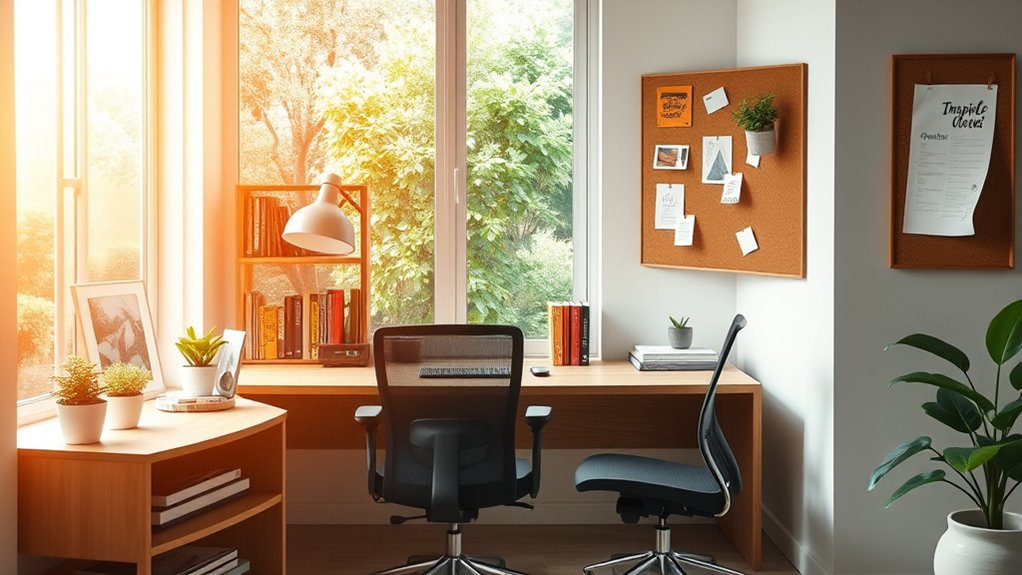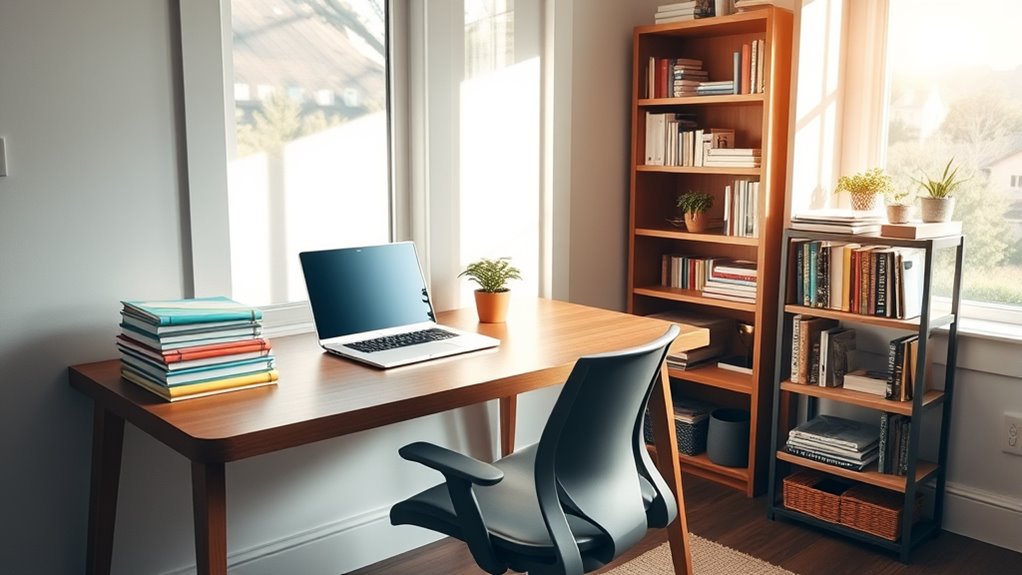To create a productive study space at home, choose ergonomic furniture that supports your body and reduces strain, and set up good lighting—maximize natural light or use warm artificial options. Keep your area tidy by organizing supplies and removing clutter, which helps boost focus. Designate a specific zone for study to reinforce routines and minimize distractions. If you keep optimizing your space, you’ll find it easier to stay motivated and focused each day.
Key Takeaways
- Choose ergonomic furniture with adjustable features to support comfort and reduce physical strain during study sessions.
- Maximize natural light and supplement with warm artificial lighting to enhance alertness and reduce eye fatigue.
- Keep the area organized with storage solutions to minimize distractions and maintain a tidy workspace.
- Designate a specific study zone that encourages focus and creates a routine environment.
- Regularly assess and adjust the space to optimize comfort, lighting, and organization for sustained productivity.

Creating an effective study space at home can considerably boost your focus and productivity. When you design your environment thoughtfully, you eliminate distractions and create a setting that encourages consistent, efficient work. One of the most important aspects to consider is choosing ergonomic furniture. A comfortable, supportive chair and a desk that fits your height can make a significant difference in how long you can work without discomfort. Ergonomic furniture helps you maintain good posture, reducing strain on your neck, back, and wrists. This means less fatigue and fewer distractions caused by discomfort, allowing you to stay engaged with your tasks longer. Invest in a chair with adjustable height and lumbar support, and ensure your desk is at the right level so your feet rest flat on the floor and your arms are at a comfortable angle when typing or writing.
In addition to furniture, ambient lighting plays a vital role in creating an inviting and functional study space. Natural light is ideal, so position your desk near a window if possible. If natural light isn’t available or insufficient, supplement it with well-placed artificial lighting. Use a combination of ambient lighting—such as ceiling fixtures or soft overhead lights—and task lighting, like a desk lamp, to illuminate your workspace evenly. Avoid harsh, direct lights that can cause glare or eye strain. Instead, aim for a warm, yet bright light that mimics natural daylight to keep your mind alert and reduce eye fatigue. Adjust your lighting based on the time of day to maintain consistency in your focus. Being aware of market trends and insights related to your environment can also help you optimize your study setup for better results.
Beyond furniture and lighting, keep your study area organized and clutter-free. A tidy space minimizes distractions and helps you stay on task. Use storage solutions like shelves, drawers, or organizers to keep supplies within easy reach but out of sight when not in use. Personalize your space with motivational quotes or a few plants to make it more inviting, but avoid over-cluttering, which can be distracting. Establishing a designated study zone in your home signals to your brain that it’s time to focus, making it easier to switch into work mode. Remember, your environment should support your workflow, so regularly assess and adjust your setup to guarantee it remains conducive to productivity. By paying attention to ergonomic furniture and ambient lighting, you create a space where you can work comfortably and efficiently, ultimately helping you stay motivated and achieve your academic goals.
Frequently Asked Questions
How Can I Reduce Distractions in My Study Area?
You can reduce distractions in your study area by creating a distraction-free zone and focusing on noise reduction. Use noise-canceling headphones or soft background music to block out noise and keep your environment calm. Declutter your space to minimize visual distractions, and set boundaries with family or housemates to ensure uninterrupted study time. Keeping your study area organized and quiet helps you stay focused and enhances your productivity.
What Lighting Is Best for a Study Space?
Your study space needs lighting so brilliant it can make your brain feel like it’s on fire! Use task lighting to focus directly on your work, preventing eye strain and boosting concentration. Combine this with soft ambient lighting to create a cozy environment that keeps you alert without glare. When balanced perfectly, your lighting setup makes studying feel effortless, energizing your mind and transforming your space into a productivity powerhouse.
How Should I Organize My Study Materials?
You should organize your study materials by using clear storage solutions like labeled bins and shelves to keep everything accessible. Incorporate digital note-taking tools to reduce paper clutter and make it easier to find information quickly. Regularly review and tidy your supplies, storing items you rarely use out of sight. This way, your space stays tidy, and you can focus on your work without distractions.
What Ergonomic Furniture Promotes Better Posture?
You should choose ergonomic chairs that provide proper lumbar support and encourage good posture. An adjustable desk allows you to customize your height, preventing strain during long study sessions. Look for furniture with adjustable features so you can switch positions easily and stay comfortable. Combining ergonomic chairs with adjustable desks creates a healthier, more productive environment, reducing discomfort and helping you focus better on your studies.
How Can I Personalize My Study Space Without Clutter?
To personalize your study space without clutter, add decorative accessories like inspiring artwork or a unique lamp, and choose a calming color scheme to create a welcoming atmosphere. Keep your desk tidy by selecting a few meaningful items instead of overcrowding it. Use storage solutions like baskets or organizers to neatly stow away extras, allowing your space to reflect your personality while remaining functional and clutter-free.
Conclusion
Creating a dedicated, organized study space at home can boost your productivity by up to 25%. When you design your environment thoughtfully, you’re more likely to stay focused and motivated. Remember, small changes like good lighting and minimal distractions make a big difference. So, take a moment to set up your ideal study spot—you’ll be surprised how much easier it is to stay on top of your goals and succeed.









